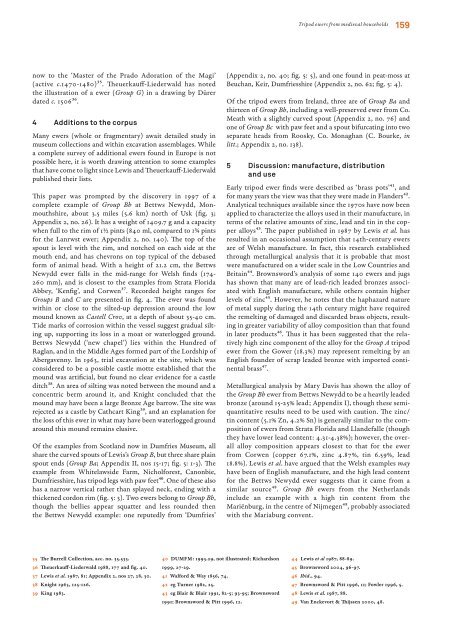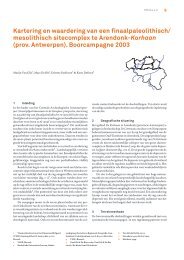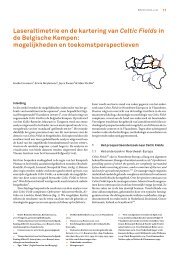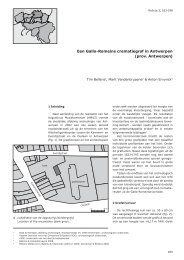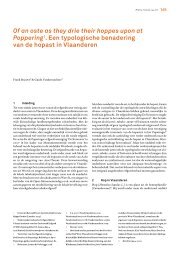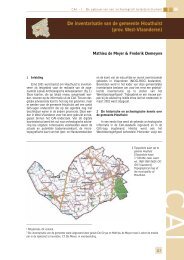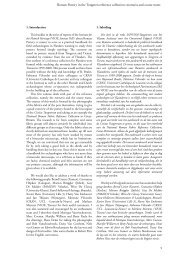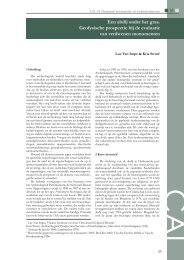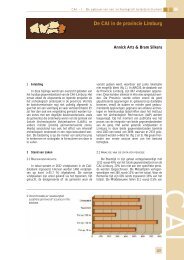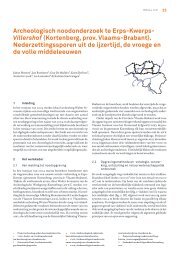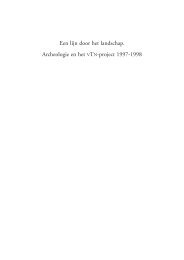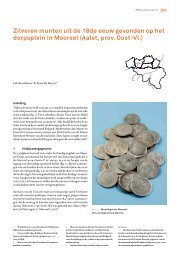Exchanging Medieval Material Culture Studies on archaeology and ...
Exchanging Medieval Material Culture Studies on archaeology and ...
Exchanging Medieval Material Culture Studies on archaeology and ...
Create successful ePaper yourself
Turn your PDF publications into a flip-book with our unique Google optimized e-Paper software.
now to the ‘Master of the Prado Adorati<strong>on</strong> of the Magi’<br />
(active c.1470-1480)35. Th euerkauff -Liederwald has noted<br />
the illustrati<strong>on</strong> of a ewer (Group G) in a drawing by Dürer<br />
dated c. 150636.<br />
4 Additi<strong>on</strong>s to the corpus<br />
Many ewers (whole or fragmentary) await detailed study in<br />
museum collecti<strong>on</strong>s <strong>and</strong> within excavati<strong>on</strong> assemblages. While<br />
a complete survey of additi<strong>on</strong>al ewers found in Europe is not<br />
possible here, it is worth drawing attenti<strong>on</strong> to some examples<br />
that have come to light since Lewis <strong>and</strong> Th euerkauff -Liederwald<br />
published their lists.<br />
Th is paper was prompted by the discovery in 1997 of a<br />
complete example of Group Bb at Bettws Newydd, M<strong>on</strong>mouthshire,<br />
about 3.5 miles (5.6 km) north of Usk (fi g. 3;<br />
Appendix 2, no. 26). It has a weight of 1409.7 g <strong>and</strong> a capacity<br />
when full to the rim of 1½ pints (840 ml, compared to 1¾ pints<br />
for the Lanrwst ewer; Appendix 2, no. 140). Th e top of the<br />
spout is level with the rim, <strong>and</strong> notched <strong>on</strong> each side at the<br />
mouth end, <strong>and</strong> has chevr<strong>on</strong>s <strong>on</strong> top typical of the debased<br />
form of animal head. With a height of 21.2 cm, the Bettws<br />
Newydd ewer falls in the mid-range for Welsh fi nds (174-<br />
260 mm), <strong>and</strong> is closest to the examples from Strata Florida<br />
Abbey, ‘Kenfi g’, <strong>and</strong> Corwen37. Recorded height ranges for<br />
Groups B <strong>and</strong> C are presented in fi g. 4. Th e ewer was found<br />
within or close to the silted-up depressi<strong>on</strong> around the low<br />
mound known as Castell Crov, at a depth of about 35-40 cm.<br />
Tide marks of corrosi<strong>on</strong> within the vessel suggest gradual silting<br />
up, supporting its loss in a moat or waterlogged ground.<br />
Bettws Newydd (‘new chapel’) lies within the Hundred of<br />
Raglan, <strong>and</strong> in the Middle Ages formed part of the Lordship of<br />
Abergavenny. In 1963, trial excavati<strong>on</strong> at the site, which was<br />
c<strong>on</strong>sidered to be a possible castle motte established that the<br />
mound was artifi cial, but found no clear evidence for a castle<br />
ditch38. An area of silting was noted between the mound <strong>and</strong> a<br />
c<strong>on</strong>centric berm around it, <strong>and</strong> Knight c<strong>on</strong>cluded that the<br />
mound may have been a large Br<strong>on</strong>ze Age barrow. Th e site was<br />
rejected as a castle by Cathcart King39, <strong>and</strong> an explanati<strong>on</strong> for<br />
the loss of this ewer in what may have been waterlogged ground<br />
around this mound remains elusive.<br />
Of the examples from Scotl<strong>and</strong> now in Dumfries Museum, all<br />
share the curved spouts of Lewis’s Group B, but three share plain<br />
spout ends (Group Ba; Appendix II, nos 15-17; fi g. 5: 1-3). Th e<br />
example from Whitelawside Farm, Nicholforest, Can<strong>on</strong>bie,<br />
Dumfriesshire, has tripod legs with paw feet40. One of these also<br />
has a narrow vertical rather than splayed neck, ending with a<br />
thickened cord<strong>on</strong> rim (fi g. 5: 3). Two ewers bel<strong>on</strong>g to Group Bb,<br />
though the bellies appear squatter <strong>and</strong> less rounded then<br />
the Bettws Newydd example: <strong>on</strong>e reputedly from ‘Dumfries’<br />
35 Th e Burrell Collecti<strong>on</strong>, acc. no. 35.533.<br />
36 Th euerkauff -Liederwald 1988, 177 <strong>and</strong> fi g. 40.<br />
37 Lewis et al. 1987, 81; Appendix 2, nos 27, 28, 30.<br />
38 Knight 1963, 125-126.<br />
39 King 1983.<br />
40 DUMFM: 1993.29, not illustrated; Richards<strong>on</strong><br />
1999, 27-29.<br />
41 Walford & Way 1856, 74.<br />
42 eg Turner 1982, 25.<br />
43 eg Blair & Blair 1991, 82-5; 93-95; Brownsword<br />
1991; Brownsword & Pitt 1996, 12.<br />
Tripod ewers from medieval households 159<br />
(Appendix 2, no. 40; fi g. 5: 5), <strong>and</strong> <strong>on</strong>e found in peat-moss at<br />
Beuchan, Keir, Dumfriesshire (Appendix 2, no. 62; fi g. 5: 4).<br />
Of the tripod ewers from Irel<strong>and</strong>, three are of Group Ba <strong>and</strong><br />
thirteen of Group Bb, including a well-preserved ewer from Co.<br />
Meath with a slightly curved spout (Appendix 2, no. 76) <strong>and</strong><br />
<strong>on</strong>e of Group Bc with paw feet <strong>and</strong> a spout bifurcating into two<br />
separate heads from Roosky, Co. M<strong>on</strong>aghan (C. Bourke, in<br />
litt.; Appendix 2, no. 138).<br />
5 Discussi<strong>on</strong>: manufacture, distributi<strong>on</strong><br />
<strong>and</strong> use<br />
Early tripod ewer fi nds were described as ‘brass pots’41, <strong>and</strong><br />
for many years the view was that they were made in Fl<strong>and</strong>ers42.<br />
Analytical techniques available since the 1970s have now been<br />
applied to characterize the alloys used in their manufacture, in<br />
terms of the relative amounts of zinc, lead <strong>and</strong> tin in the copper<br />
alloys43. Th e paper published in 1987 by Lewis et al. has<br />
resulted in an occasi<strong>on</strong>al assumpti<strong>on</strong> that 14th-century ewers<br />
are of Welsh manufacture. In fact, this research established<br />
through metallurgical analysis that it is probable that most<br />
were manufactured <strong>on</strong> a wider scale in the Low Countries <strong>and</strong><br />
Britain44. Brownsword’s analysis of some 140 ewers <strong>and</strong> jugs<br />
has shown that many are of lead-rich leaded br<strong>on</strong>zes associated<br />
with English manufacture, while others c<strong>on</strong>tain higher<br />
levels of zinc45. However, he notes that the haphazard nature<br />
of metal supply during the 14th century might have required<br />
the remelting of damaged <strong>and</strong> discarded brass objects, resulting<br />
in greater variability of alloy compositi<strong>on</strong> than that found<br />
in later products46. Th us it has been suggested that the relatively<br />
high zinc comp<strong>on</strong>ent of the alloy for the Group A tripod<br />
ewer from the Gower (18.3%) may represent remelting by an<br />
English founder of scrap leaded br<strong>on</strong>ze with imported c<strong>on</strong>tinental<br />
brass47.<br />
Metallurgical analysis by Mary Davis has shown the alloy of<br />
the Group Bb ewer from Bettws Newydd to be a heavily leaded<br />
br<strong>on</strong>ze (around 15-25% lead; Appendix I), though these semiquantitative<br />
results need to be used with cauti<strong>on</strong>. Th e zinc/<br />
tin c<strong>on</strong>tent (5.1% Zn, 4.2% Sn) is generally similar to the compositi<strong>on</strong><br />
of ewers from Strata Florida <strong>and</strong> Ll<strong>and</strong>efalle (though<br />
they have lower lead c<strong>on</strong>tent: 4.31-4.38%); however, the overall<br />
alloy compositi<strong>on</strong> appears closest to that for the ewer<br />
from Corwen (copper 67.1%, zinc 4.87%, tin 6.59%, lead<br />
18.8%). Lewis et al. have argued that the Welsh examples may<br />
have been of English manufacture, <strong>and</strong> the high lead c<strong>on</strong>tent<br />
for the Bettws Newydd ewer suggests that it came from a<br />
similar source48. Group Bb ewers from the Netherl<strong>and</strong>s<br />
include an example with a high tin c<strong>on</strong>tent from the<br />
Mariënburg, in the centre of Nijmegen49, probably associated<br />
with the Mariaburg c<strong>on</strong>vent.<br />
44 Lewis et al 1987, 88-89.<br />
45 Brownsword 2004, 96-97.<br />
46 Ibid., 94.<br />
47 Brownsword & Pitt 1996, 11; Fowler 1996, 5.<br />
48 Lewis et al. 1987, 88.<br />
49 Van Enckevort & Th ijssen 2000, 48.


